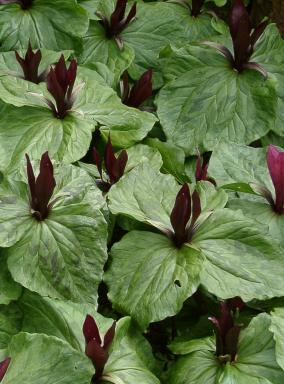
Trillium chloropetalum, also known as giant trillium, giant wakerobin, or common trillium, is a species of flowering plant in the family Melanthiaceae. It is endemic to the western U.S. state of California, being especially frequent in and around the San Francisco Bay Area.

Tsuga caroliniana, the Carolina hemlock, is a species of hemlock endemic to the United States. As of 2023, it is under review for listing under the Endangered Species Act of 1973.

Olsynium douglasii is a species of flowering plant in the iris family (Iridaceae). Common names include Douglas' olsynium, Douglas' grasswidow, grass-widow, blue-eyed grass, purple-eyed-grass, and satin flower, It is the only species in the genus Olsynium in North America, the remaining 11 species being from South America. It was formerly treated in the related genus Sisyrinchium. Despite the common names, it is not a true grass (Poaceae).

Eurybia divaricata, the white wood aster, is an herbaceous plant native to eastern North America. It occurs in the eastern United States, primarily in the Appalachian Mountains, though it is also present in southeastern Canada, but only in about 25 populations in the provinces of Ontario and Quebec. In the U.S. it is abundant and common, but in Canada it is considered threatened due to its restricted distribution. It has been introduced to a number of countries in Europe. It can be found in dry open woods as well as along wood-edges and clearings. The species is distinguished by its flower heads that have yellow centers and white rays that are arranged in flat-topped corymbiform arrays, emerging in the late summer through fall. Other distinguishing characteristics include its serpentine stems and sharply serrated narrow heart-shaped leaves. The white wood aster is sometimes used in cultivation in both North America and Europe due to it being quite tough and for its showy flowers.

Sisyrinchium montanum, the blue-eyed-grass, American blue-eyed-grass, or strict blue-eyed grass, is a grass-like species of plant from the genus Sisyrinchium, native to northern North America from Newfoundland west to easternmost Alaska, and south to Pennsylvania in the east, and to New Mexico in the Rocky Mountains. It has also been introduced to parts of France, likely during the First World War.

Dudleya farinosa is a species of succulent plant in the family Crassulaceae known by several common names, including bluff lettuce, powdery liveforever, and powdery dudleya. A coastal plant of northern California and southern Oregon, it is typically found on oceanic bluffs just directly above the reach of the waves. Its appearance is characterized by lotus-like rosettes of beveled leaves, and in summer the plant erects a tall pink to red stem densely covered in foliage, topped with branches adorned with pale yellow flowers. The green or white rosettes of this plant can be seen covering stretches of rocky coast and nearby islets.

Sisyrinchium idahoense, the Idaho blue-eyed grass, is a perennial that is native to western North America. It is not a true grass, but is instead in the family Iridaceae.

Salvia brandegeei is a perennial evergreen shrub in the mint family known by the common names Santa Rosa Island sage or Brandegee's sage. It is a fragrant plant characterized by lavender flowers and dark green leaves. For many years, it was thought to be native only to Santa Rosa Island, one of the Channel Islands of California, until it was discovered along the coast of Baja California. It is threatened by development and mining along the mainland portions of its range, but otherwise has a stable population on Santa Rosa Island.

Trillium albidum is a species of flowering plant in the bunchflower family Melanthiaceae. It is the only trillium characterized by a stalkless white flower. The species is endemic to the western United States, ranging from central California through Oregon to southwestern Washington. In the San Francisco Bay Area, it is often confused with a white-flowered form of Trillium chloropetalum. In northern Oregon and southwestern Washington, it has a smaller, less conspicuous flower.
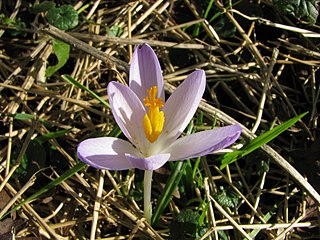
Crocus tommasinianus, the woodland crocus, early crocus, or Tommasini's crocus, is a flower named after the botanist Muzio G. Spirito de Tommasini (1794-1879). It is native to Bulgaria, Hungary, Albania, and the former Yugoslavia. It is often referred to as the early or snow crocus, but these terms are shared with several other species, although C. tommasinianus is amongst the first to bloom. Multiple plants are often called tommies in the horticultural trade.

Sisyrinchium pruinosum, the dotted blue-eyed grass, is a perennial plant in the family Iridaceae, native to the south-central United States. There are also reports of the plant in California, but these appear to represent naturalizations. It is sometimes considered to be a synonym of Sisyrinchium langloisii.

Sisyrinchium elmeri is a species of flowering plant in the family Iridaceae known by the common name Elmer's blue-eyed grass. It is endemic to California, where it is known from many of the mountain ranges from the Klamath Mountains through the Sierra Nevada to the San Bernardino Mountains. It grows in moist habitat types such as meadows and bogs.
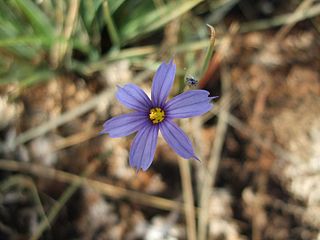
Sisyrinchium funereum is an uncommon species of flowering plant in the family Iridaceae known by the common names Funeral Mountain blue-eyed grass and Death Valley blue-eyed-grass. It is endemic to the Mojave Desert of the United States, where it is known only from the Funeral Mountains and Death Valley area in eastern California, and the Ash Meadows area just over the border in Nevada. It grows in wet, highly alkaline habitat, such as seeps and mineral springs.
Sisyrinchium halophilum is a species of flowering plant in the family Iridaceae known by the common name Nevada blue-eyed grass. It is native to the western United States in and around the Great Basin and Mojave Desert, where it grows in moist, often highly alkaline habitat, such as seeps, meadows, and mineral springs.

Clintonia umbellulata, commonly known as white clintonia or speckled wood-lily, is a species of flowering plant in the lily family Liliaceae. The specific epithet umbellulata means "umbelled," which refers to the shape of the plant’s inflorescence.

Solanum diphyllum, commonly known as the twoleaf nightshade, is a species of nightshade native to the Americas. It is cultivated as an ornamental plant for its clusters of dark green round fruits that turn a bright yellow when ripe.

Orbexilum pedunculatum, commonly known as Sampson's snakeroot, is a species of flowering plant in the legume family. It is native primarily to the Southeastern United States where it is found in prairies and savannas, often in acidic soil. It is a perennial that produces racemes of flowers in early summer.
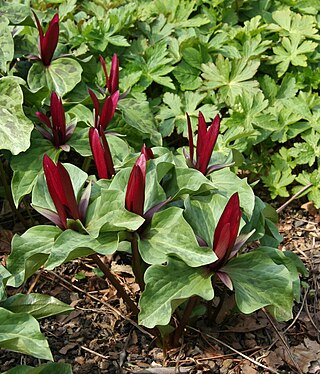
Trillium kurabayashii is a species of flowering plant in the bunchflower family Melanthiaceae. The species is endemic to the western United States, occurring in extreme southwestern Oregon, northwestern California, and the Sierra Nevada of northern California. It was first described by John Daniel Freeman in 1975. The specific epithet kurabayashii honors Masataka Kurabayashi, a Japanese cytologist and population geneticist who first postulated the taxon’s existence. It is commonly known as the giant purple wakerobin, a reference to its conspicuously large, dark purple-red flower, one of the largest of any sessile-flowered trillium.
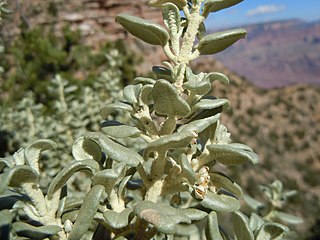
Shepherdia rotundifolia, the roundleaf buffaloberry or silverleaf, is a 3-to-6-foot (1-to-2-meter) evergreen shrub in the oleaster family (Elaeagnaceae) that grows only in the Colorado Plateau (endemic) of the southwestern United States. The common name comes from western settlers using the cooked berries in a sauce for eating cooked buffalo meat.

Penstemon ambiguus, commonly known as the bush penstemon, pink plains penstemon, or gilia beardtongue is a species of Penstemon that grows in the shortgrass prairies and deserts of the western United States and northern Mexico. This bush like penstemon grows in sandy, loose, and creosote soils and is particularly known for the spectacular flowering show it produces, sometime seasons turning whole hillsides bright pink–white.




















